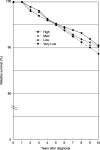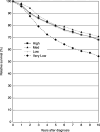Population-based study of the relationship between hospital surgical volume and 10-year survival of breast cancer patients in Osaka, Japan
- PMID: 16827802
- PMCID: PMC11160065
- DOI: 10.1111/j.1349-7006.2006.00215.x
Population-based study of the relationship between hospital surgical volume and 10-year survival of breast cancer patients in Osaka, Japan
Abstract
Breast cancer is the most prevalent cancer among Japanese women; however, its outcome has never been analyzed in relation to hospital volume in Japan. We utilized data from the Osaka Cancer Registry for investigating correlations between hospital volume and 10-year survival of breast cancer patients. According to the total number of surgical procedures of breast cancer in each hospital during the period 1985-1991, we classified reporting hospitals in Osaka into four categories (high, medium, low, very low). The survival analysis was restricted to the 4333 female patients reported who were 30-64 years old, living in Osaka Prefecture (except for Osaka City), and for whom active follow up was available more than 10 years after diagnosis. In total, the relative 10-year survival was 79.7% in the high-volume, 80.3% in the medium-volume, 78.2% in the low-volume, and 68.2% in the very low-volume hospitals. After adjustment for age at diagnosis, clinical stage and clues for detection with the Cox regression model, the patients who received care in the very low-volume hospitals had a significantly higher risk of death than those in the high-volume hospitals. Meanwhile, no significant differences in risk were observed for the other two categories. These findings led us to conclude that the surgical volume of the hospitals did not affect the 10-year survival rate significantly, except for the very low-volume hospitals in Osaka, Japan. However, the study of these relationships should be continued and expanded in future to include quality of life.
Figures
Similar articles
-
Influence of hospital procedure volume on uterine cancer survival in Osaka, Japan.Cancer Sci. 2005 Oct;96(10):689-94. doi: 10.1111/j.1349-7006.2005.00094.x. Cancer Sci. 2005. PMID: 16232201 Free PMC article.
-
Influence of hospital procedure volume on ovarian cancer survival in Japan, a country with low incidence of ovarian cancer.Cancer Sci. 2004 Mar;95(3):233-7. doi: 10.1111/j.1349-7006.2004.tb02208.x. Cancer Sci. 2004. PMID: 15016322 Free PMC article.
-
Population-based study of relationship between hospital surgical volume and 5-year survival of stomach cancer patients in Osaka, Japan.Cancer Sci. 2003 Nov;94(11):998-1002. doi: 10.1111/j.1349-7006.2003.tb01391.x. Cancer Sci. 2003. PMID: 14611678 Free PMC article.
-
Hospital volume and postoperative 5-year survival for five different cancer sites: A population-based study in Japan.Cancer Sci. 2020 Mar;111(3):985-993. doi: 10.1111/cas.14309. Epub 2020 Feb 3. Cancer Sci. 2020. PMID: 31943492 Free PMC article.
-
[Trends of cancer occurrence and survival in Japan, and in Osaka].Gan To Kagaku Ryoho. 1992 Jul;19(7):933-40. Gan To Kagaku Ryoho. 1992. PMID: 1626948 Review. Japanese.
Cited by
-
Lateral neck dissection surgeon volume and complications in head and neck endocrine malignancy.Gland Surg. 2023 Jul 31;12(7):917-927. doi: 10.21037/gs-22-385. Epub 2023 Jul 10. Gland Surg. 2023. PMID: 37727340 Free PMC article.
-
Does Center Volume Correlate with Survival from Breast Cancer?Breast Care (Basel). 2009;4(4):237-244. doi: 10.1159/000229531. Epub 2009 Aug 12. Breast Care (Basel). 2009. PMID: 20877661 Free PMC article.
-
Reexamining the Relationship of Breast Cancer Hospital and Surgical Volume to Mortality: An Instrumental Variable Analysis.Med Care. 2015 Dec;53(12):1033-9. doi: 10.1097/MLR.0000000000000439. Med Care. 2015. PMID: 26492213 Free PMC article.
-
Hospital Surgical Volume and 3-Year Mortality in Severe Prognosis Cancers: A Population-Based Study Using Cancer Registry Data.J Epidemiol. 2021 Jan 5;31(1):52-58. doi: 10.2188/jea.JE20190242. Epub 2020 Jan 11. J Epidemiol. 2021. PMID: 31932528 Free PMC article.
-
Socioeconomic and racial differences in treatment for breast cancer at a low-volume hospital.Ann Surg Oncol. 2011 Oct;18(11):3220-7. doi: 10.1245/s10434-011-2001-z. Epub 2011 Aug 23. Ann Surg Oncol. 2011. PMID: 21861226 Free PMC article.
References
-
- Research Group for Population‐Based Cancer Registration in Japan. Cancer incidence and incidence rates in Japan in 1999: Estimates based on data from 11 population‐based cancer registries. Jpn J Clin Oncol 2004; 34: 352–6. - PubMed
-
- Parkin DM, Whelan SL, Ferlay J, Teppo L, Thomas DB. Cancer Incidence in Five Continents, Volume VIII. IARC Scientific Publications No. 155. Lyon, France: International Agency for Research on Cancer, 2002.
-
- Ajiki W, Tsukuma H, Oshima A. Trends in cancer incidence and survival in Osaka. In: Tajima K, Kuroishi T, Oshima A, eds. Cancer Mortality and Morbidity Statistics: Japan and the World, 2004. Gann Monograph on Cancer Research no. 51. Tokyo: Japan Science Society Press, 2004; 137–63.
MeSH terms
LinkOut - more resources
Full Text Sources
Medical



